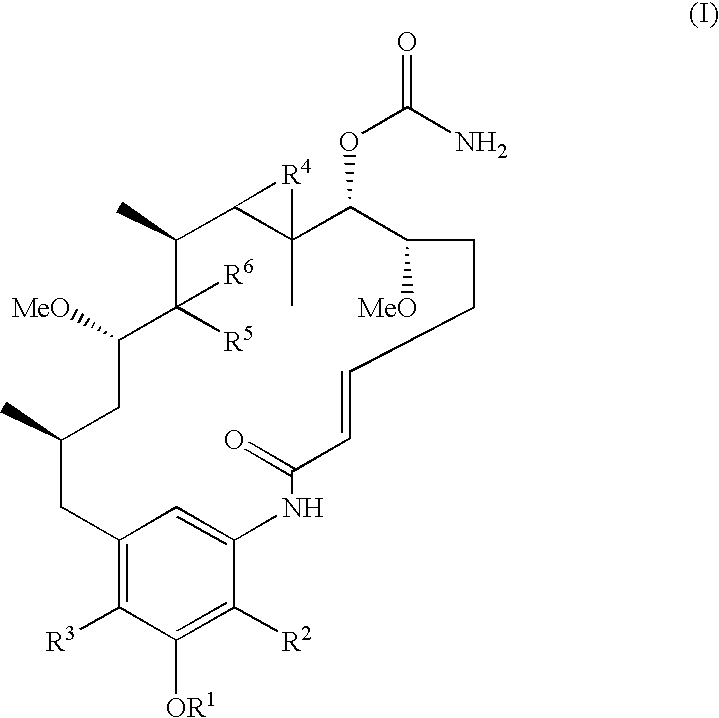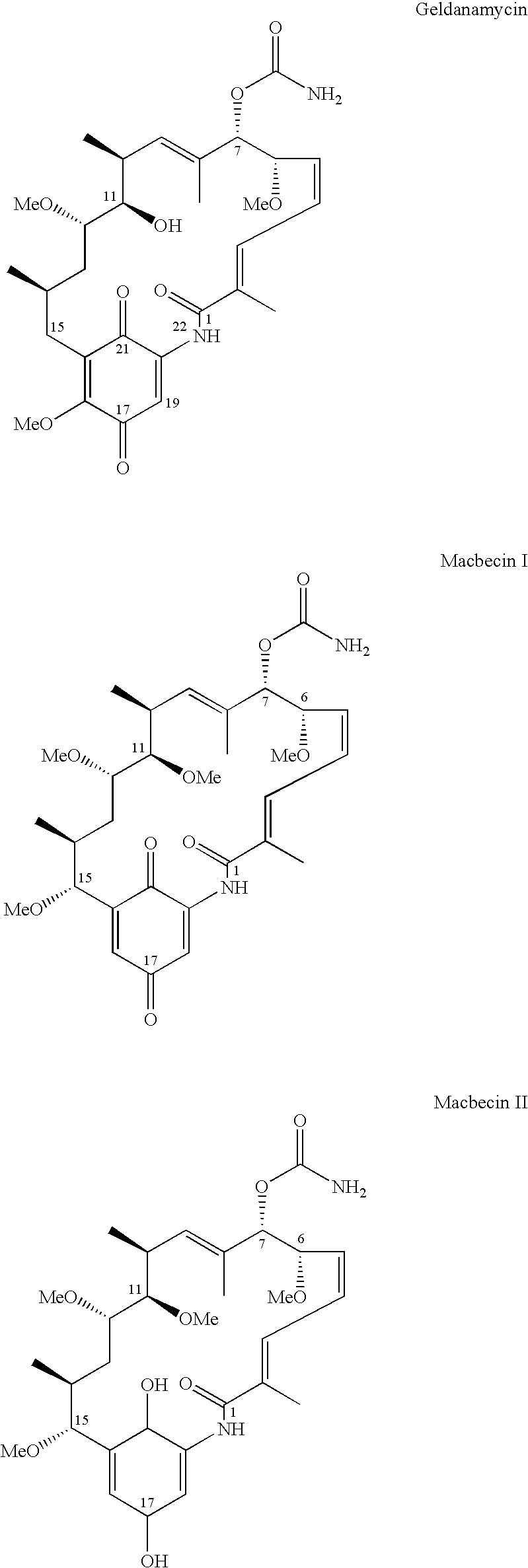2-Desmethyl ansamycin compounds
a technology of ansamycin and methyl ansamycin, applied in the field of 2desmethyl ansamycin compounds, can solve the problems of reducing the resistance of proteasome-mediated destruction of ansamycin, and discontinuing the clinical candidate as a clinical candidate, and achieve the effect of reducing potential side effects
- Summary
- Abstract
- Description
- Claims
- Application Information
AI Technical Summary
Benefits of technology
Problems solved by technology
Method used
Image
Examples
example 1
S. hygroscopicus strain K309-1
This example describes the substitution of the gdmAT7 domain (which accepts a 2-methymalonyl extender unit) in the geldanamycin PKS with the AT domain the second module of the rapamycin PKS (rapAT2), which accepts a malonyl extender unit, and the transformation of S. hygroscopicus with the modified PKS to produce strain K309-1. Strain K309-1 produces compounds 1-A, III, and IV.
Plasmid and delivery vectors were constructed by cloning DNA flanking the AT domains to be substituted in the geldanamycin PKS. The heterologous AT domain used for the substitution was inserted between the flanking fragments and the vector was introduced into the geldanamycin producing organism, Streptomyces hygroscopicus NRRL3602. Replacement of the gdmAT7 domain occurs through stepwise double crossing over (homologous recombination).
Two DNA fragments (˜1.3 kb) flanking on either side of the AT7 domain were PCR amplified from cosmid pKOS256-107-3 with the following oligonuc...
example 2
Compounds 1-A, III and IV
Cell banks of S. hygroscopicus K309-1 were prepared by fermenting in R5 medium at 30° C. for 2-3 days and storing in 30% glycerol at −80° C. Cell banks were used to inoculate seed cultures in R5 and grown to stationary phase (˜2-3 days). Production was carried out in 250 mL baffled flasks containing 40 mL of GPM medium and 1.6 g of Amberlite™ XAD resin (Rohm & Haas). The production flasks (50 total) were inoculated with 5% seed each and grown at 30° C. for 4 days. At the end of day 4, the flasks were pooled, centrifuged, and the supernatant decanted without loosing any XAD resin, onto which polyketide product had been adsorbed. To separate cells from the XAD resin, the mixture was re-suspended in water and the XAD resin was allowed to settle. The supernatant with suspended cells was decanted. This procedure was repeated 2-3 times until most of the mycelia was gone. The XAD resin was then filtered using a separation funnel with Whatman™ filter paper and was...
example 3
Procedure A
18-O-ether compounds were prepared according to Procedure A using the following general protocol: To a solution of compound 1-A (1 equiv.) in dry acetone (˜10 mmol / L) was added potassium carbonate powder (3 equiv.) and an alkyl halide (2 equiv.). The mixture was heated to 60° C. and stirred for 16 h (or until all starting material was consumed). The mixture was concentrated on a rotary evaporator, re-suspended in ethyl acetate, washed sequentially with water, saturated sodium bicarbonate (aq.), and saturated sodium chloride (aq.). The organic phase was dried over anhydrous sodium sulfate, filtered, and evaporated to dryness. The crude product was purified by reversed phase HPLC, eluted using a gradient of water / acetonitrile. The 18-O-alkyl ether analogs were obtained as white solids. The 18-O, 22-N-dialkyl analogs were isolated in several cases.
The following compounds were made according to the above procedure, with the halide used identified parenthetically.
Compoun...
PUM
| Property | Measurement | Unit |
|---|---|---|
| Fraction | aaaaa | aaaaa |
| Structure | aaaaa | aaaaa |
| Hyperproliferative | aaaaa | aaaaa |
Abstract
Description
Claims
Application Information
 Login to View More
Login to View More - R&D
- Intellectual Property
- Life Sciences
- Materials
- Tech Scout
- Unparalleled Data Quality
- Higher Quality Content
- 60% Fewer Hallucinations
Browse by: Latest US Patents, China's latest patents, Technical Efficacy Thesaurus, Application Domain, Technology Topic, Popular Technical Reports.
© 2025 PatSnap. All rights reserved.Legal|Privacy policy|Modern Slavery Act Transparency Statement|Sitemap|About US| Contact US: help@patsnap.com



